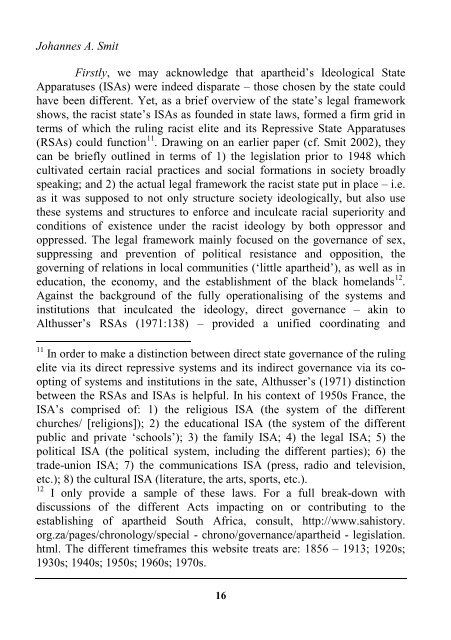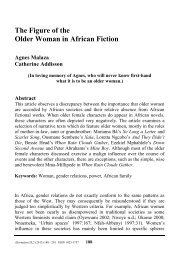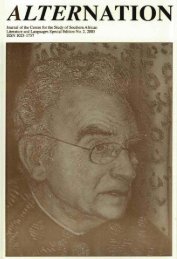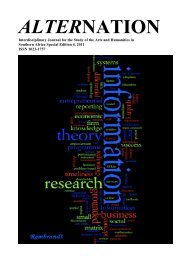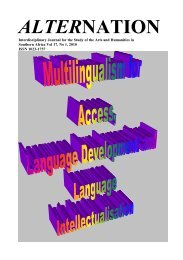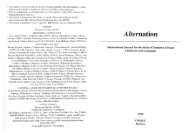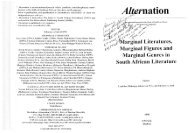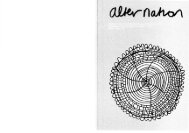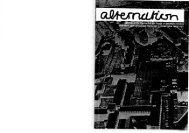- Page 1 and 2: ALTERNATION Interdisciplinary Journ
- Page 3 and 4: Alternation Interdisciplinary Journ
- Page 5 and 6: Editorial Urmilla Bob Kamilla Swart
- Page 7 and 8: 3 Editorial hosting the FIFA World
- Page 9 and 10: 5 Editorial key issue before the ev
- Page 11 and 12: 7 Editorial aspects pertinent to sp
- Page 13 and 14: Dennis Brutus: Activist for Non-rac
- Page 15 and 16: Dennis Brutus: Activist for Non-rac
- Page 17 and 18: Dennis Brutus: Activist for Non-rac
- Page 19: Dennis Brutus: Activist for Non-rac
- Page 23 and 24: Dennis Brutus: Activist for Non-rac
- Page 25 and 26: Dennis Brutus: Activist for Non-rac
- Page 27 and 28: Dennis Brutus: Activist for Non-rac
- Page 29 and 30: Dennis Brutus: Activist for Non-rac
- Page 31 and 32: Dennis Brutus: Activist for Non-rac
- Page 33 and 34: Dennis Brutus: Activist for Non-rac
- Page 35 and 36: Dennis Brutus: Activist for Non-rac
- Page 37 and 38: Dennis Brutus: Activist for Non-rac
- Page 39 and 40: Dennis Brutus: Activist for Non-rac
- Page 41 and 42: Dennis Brutus: Activist for Non-rac
- Page 43 and 44: Dennis Brutus: Activist for Non-rac
- Page 45 and 46: Dennis Brutus: Activist for Non-rac
- Page 47 and 48: Dennis Brutus: Activist for Non-rac
- Page 49 and 50: Dennis Brutus: Activist for Non-rac
- Page 51 and 52: Dennis Brutus: Activist for Non-rac
- Page 53 and 54: Dennis Brutus: Activist for Non-rac
- Page 55 and 56: Dennis Brutus: Activist for Non-rac
- Page 57 and 58: Dennis Brutus: Activist for Non-rac
- Page 59 and 60: Dennis Brutus: Activist for Non-rac
- Page 61 and 62: Dennis Brutus: Activist for Non-rac
- Page 63 and 64: Dennis Brutus: Activist for Non-rac
- Page 65 and 66: Dennis Brutus: Activist for Non-rac
- Page 67 and 68: Dennis Brutus: Activist for Non-rac
- Page 69 and 70: levels 33 Dennis Brutus: Activist f
- Page 71 and 72:
Dennis Brutus: Activist for Non-rac
- Page 73 and 74:
Dennis Brutus: Activist for Non-rac
- Page 75 and 76:
Dennis Brutus: Activist for Non-rac
- Page 77 and 78:
73 Sport Events and Social Legacies
- Page 79 and 80:
75 Sport Events and Social Legacies
- Page 81 and 82:
77 Sport Events and Social Legacies
- Page 83 and 84:
79 Sport Events and Social Legacies
- Page 85 and 86:
Economic legacy 81 Sport Events and
- Page 87 and 88:
83 Sport Events and Social Legacies
- Page 89 and 90:
85 Sport Events and Social Legacies
- Page 91 and 92:
87 Sport Events and Social Legacies
- Page 93 and 94:
FIFA (2011:3) further states: 89 Sp
- Page 95 and 96:
91 Sport Events and Social Legacies
- Page 97 and 98:
93 Sport Events and Social Legacies
- Page 99 and 100:
95 Sport Events and Social Legacies
- Page 101 and 102:
On the Political Economy of ‘Feel
- Page 103 and 104:
On the Political Economy of ‘Feel
- Page 105 and 106:
On the Political Economy of ‘Feel
- Page 107 and 108:
On the Political Economy of ‘Feel
- Page 109 and 110:
On the Political Economy of ‘Feel
- Page 111 and 112:
On the Political Economy of ‘Feel
- Page 113 and 114:
On the Political Economy of ‘Feel
- Page 115 and 116:
On the Political Economy of ‘Feel
- Page 117 and 118:
On the Political Economy of ‘Feel
- Page 119 and 120:
On the Political Economy of ‘Feel
- Page 121 and 122:
On the Political Economy of ‘Feel
- Page 123 and 124:
On the Political Economy of ‘Feel
- Page 125 and 126:
Living Close to 2010 Stadiums: Resi
- Page 127 and 128:
Living Close to 2010 Stadiums: Resi
- Page 129 and 130:
Living Close to 2010 Stadiums: Resi
- Page 131 and 132:
Living Close to 2010 Stadiums: Resi
- Page 133 and 134:
Living Close to 2010 Stadiums: Resi
- Page 135 and 136:
Living Close to 2010 Stadiums: Resi
- Page 137 and 138:
Living Close to 2010 Stadiums: Resi
- Page 139 and 140:
Living Close to 2010 Stadiums: Resi
- Page 141 and 142:
Living Close to 2010 Stadiums: Resi
- Page 143 and 144:
Living Close to 2010 Stadiums: Resi
- Page 145 and 146:
Living Close to 2010 Stadiums: Resi
- Page 147 and 148:
Living Close to 2010 Stadiums: Resi
- Page 149 and 150:
Living Close to 2010 Stadiums: Resi
- Page 151 and 152:
Residents’ Perceptions of the 201
- Page 153 and 154:
Residents’ Perceptions of the 201
- Page 155 and 156:
Residents’ Perceptions of the 201
- Page 157 and 158:
Residents’ Perceptions of the 201
- Page 159 and 160:
Residents’ Perceptions of the 201
- Page 161 and 162:
Residents’ Perceptions of the 201
- Page 163 and 164:
Residents’ Perceptions of the 201
- Page 165 and 166:
Residents’ Perceptions of the 201
- Page 167 and 168:
Residents’ Perceptions of the 201
- Page 169 and 170:
Residents’ Perceptions of the 201
- Page 171 and 172:
Residents’ Perceptions of the 201
- Page 173 and 174:
Residents’ Perceptions of the 201
- Page 175 and 176:
Residents’ Perceptions of the 201
- Page 177 and 178:
Cameroonian Fans’ Perceptions of
- Page 179 and 180:
Cameroonian Fans’ Perceptions of
- Page 181 and 182:
Cameroonian Fans’ Perceptions of
- Page 183 and 184:
Cameroonian Fans’ Perceptions of
- Page 185 and 186:
Cameroonian Fans’ Perceptions of
- Page 187 and 188:
Cameroonian Fans’ Perceptions of
- Page 189 and 190:
Cameroonian Fans’ Perceptions of
- Page 191 and 192:
Cameroonian Fans’ Perceptions of
- Page 193 and 194:
Cameroonian Fans’ Perceptions of
- Page 195 and 196:
Cameroonian Fans’ Perceptions of
- Page 197 and 198:
Cameroonian Fans’ Perceptions of
- Page 199 and 200:
Cameroonian Fans’ Perceptions of
- Page 201 and 202:
Cameroonian Fans’ Perceptions of
- Page 203 and 204:
Cameroonian Fans’ Perceptions of
- Page 205 and 206:
Business Perceptions of the 2010 FI
- Page 207 and 208:
Business Perceptions of the 2010 FI
- Page 209 and 210:
Business Perceptions of the 2010 FI
- Page 211 and 212:
Business Perceptions of the 2010 FI
- Page 213 and 214:
Business Perceptions of the 2010 FI
- Page 215 and 216:
Business Perceptions of the 2010 FI
- Page 217 and 218:
Business Perceptions of the 2010 FI
- Page 219 and 220:
Business Perceptions of the 2010 FI
- Page 221 and 222:
Business Perceptions of the 2010 FI
- Page 223 and 224:
Business Perceptions of the 2010 FI
- Page 225 and 226:
Business Perceptions of the 2010 FI
- Page 227 and 228:
Business Perceptions of the 2010 FI
- Page 229 and 230:
Media, Crime and the 2010 Soccer Wo
- Page 231 and 232:
Media, Crime and the 2010 Soccer Wo
- Page 233 and 234:
Media, Crime and the 2010 Soccer Wo
- Page 235 and 236:
Media, Crime and the 2010 Soccer Wo
- Page 237 and 238:
Media, Crime and the 2010 Soccer Wo
- Page 239 and 240:
Media, Crime and the 2010 Soccer Wo
- Page 241 and 242:
Media, Crime and the 2010 Soccer Wo
- Page 243 and 244:
Media, Crime and the 2010 Soccer Wo
- Page 245 and 246:
Media, Crime and the 2010 Soccer Wo
- Page 247 and 248:
Media, Crime and the 2010 Soccer Wo
- Page 249 and 250:
Media, Crime and the 2010 Soccer Wo
- Page 251 and 252:
Media, Crime and the 2010 Soccer Wo
- Page 253 and 254:
The 2010 FIFA World Cup, Sport Even
- Page 255 and 256:
The 2010 FIFA World Cup, Sport Even
- Page 257 and 258:
The 2010 FIFA World Cup, Sport Even
- Page 259 and 260:
The 2010 FIFA World Cup, Sport Even
- Page 261 and 262:
The 2010 FIFA World Cup, Sport Even
- Page 263 and 264:
The 2010 FIFA World Cup, Sport Even
- Page 265 and 266:
The 2010 FIFA World Cup, Sport Even
- Page 267 and 268:
The 2010 FIFA World Cup, Sport Even
- Page 269 and 270:
The 2010 FIFA World Cup, Sport Even
- Page 271 and 272:
The 2010 FIFA World Cup, Sport Even
- Page 273 and 274:
The 2010 FIFA World Cup, Sport Even
- Page 275 and 276:
The 2010 FIFA World Cup, Sport Even
- Page 277 and 278:
The 2010 FIFA World Cup, Sport Even
- Page 279 and 280:
Mega-events and Environmental Impac
- Page 281 and 282:
Mega-events and Environmental Impac
- Page 283 and 284:
Mega-events and Environmental Impac
- Page 285 and 286:
Mega-events and Environmental Impac
- Page 287 and 288:
Mega-events and Environmental Impac
- Page 289 and 290:
Walls and fences Operations and mai
- Page 291 and 292:
Mega-events and Environmental Impac
- Page 293 and 294:
Mega-events and Environmental Impac
- Page 295 and 296:
Mega-events and Environmental Impac
- Page 297 and 298:
Mega-events and Environmental Impac
- Page 299 and 300:
Mega-events and Environmental Impac
- Page 301 and 302:
The 2010 FIFA World Cup - Service D
- Page 303 and 304:
The 2010 FIFA World Cup … Through
- Page 305 and 306:
The 2010 FIFA World Cup … Through
- Page 307 and 308:
The 2010 FIFA World Cup … Through
- Page 309 and 310:
The 2010 FIFA World Cup … Through
- Page 311 and 312:
The 2010 FIFA World Cup … Through
- Page 313 and 314:
The 2010 FIFA World Cup … Through
- Page 315 and 316:
The 2010 FIFA World Cup … Through
- Page 317 and 318:
The 2010 FIFA World Cup … Through
- Page 319 and 320:
The 2010 FIFA World Cup … Through
- Page 321 and 322:
The 2010 FIFA World Cup … Through
- Page 323 and 324:
The 2010 FIFA World Cup … Through
- Page 325 and 326:
The 2010 FIFA World Cup … Through
- Page 327 and 328:
The 2010 FIFA World Cup … Through
- Page 329 and 330:
The 2010 FIFA World Cup … Through
- Page 331 and 332:
Leaders The 2010 FIFA World Cup …
- Page 333 and 334:
The 2010 FIFA World Cup … Through
- Page 335 and 336:
The 2010 FIFA World Cup … Through
- Page 337 and 338:
‘Terror(ism)’ in the Context of
- Page 339 and 340:
‘Terror(ism)’ in the Context of
- Page 341 and 342:
‘Terror(ism)’ in the Context of
- Page 343 and 344:
‘Terror(ism)’ in the Context of
- Page 345 and 346:
‘Terror(ism)’ in the Context of
- Page 347 and 348:
‘Terror(ism)’ in the Context of
- Page 349 and 350:
‘Terror(ism)’ in the Context of
- Page 351 and 352:
‘Terror(ism)’ in the Context of
- Page 353 and 354:
‘Terror(ism)’ in the Context of
- Page 355 and 356:
‘Terror(ism)’ in the Context of
- Page 357 and 358:
‘Terror(ism)’ in the Context of
- Page 359 and 360:
invincible 19 ‘Terror(ism)’ in
- Page 361 and 362:
‘Terror(ism)’ in the Context of
- Page 363 and 364:
‘Terror(ism)’ in the Context of
- Page 365 and 366:
The First Ethiopians: A Critical Pe
- Page 367 and 368:
The First Ethiopians: A Critical Pe
- Page 369 and 370:
The First Ethiopians: A Critical Pe
- Page 371 and 372:
The First Ethiopians: A Critical Pe
- Page 373 and 374:
The First Ethiopians: A Critical Pe
- Page 375 and 376:
The First Ethiopians: A Critical Pe
- Page 377 and 378:
The First Ethiopians: A Critical Pe
- Page 379 and 380:
The First Ethiopians: A Critical Pe
- Page 381 and 382:
The First Ethiopians: A Critical Pe
- Page 383 and 384:
‘A persistent letter writer - an
- Page 385 and 386:
‘A persistent letter writer - an
- Page 387 and 388:
‘A persistent letter writer - an
- Page 389 and 390:
‘A persistent letter writer - an
- Page 391 and 392:
‘A persistent letter writer - an
- Page 393 and 394:
‘A persistent letter writer - an
- Page 395 and 396:
‘A persistent letter writer - an
- Page 397 and 398:
‘A persistent letter writer - an
- Page 399 and 400:
‘A persistent letter writer - an
- Page 401 and 402:
397 Contributors researcher at the
- Page 403 and 404:
399 Contributors Fellowship at The
- Page 405 and 406:
Editorial Associates (1994 - 2010)
- Page 407 and 408:
Elsa Meihuizen (UZ) Nicholas Meihui
- Page 409:
Alternation Volume 17, No 2, 2010 I


